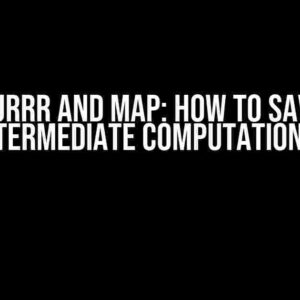Are you tired of dealing with the cluttered output of the C preprocessor? Do you want to get straight to the point and focus on the essential code? Well, you’re in luck! In this article, we’ll show you how to strip the beginning stuff from C preprocessor output, giving you a clean and concise result.
What is the C Preprocessor?
The C preprocessor is a crucial step in the C compilation process. It takes your C code as input and produces a modified version of the code that’s ready for compilation. The preprocessor performs various tasks, such as:
- Expanding macros
- Including header files
- Removing comments
- Handling conditional compilation directives
However, the preprocessor output can be overwhelming, especially for large projects. That’s where our tutorial comes in – to help you strip the unnecessary bits and get to the good stuff!
Why Strip the Beginning Stuff?
There are several reasons why you might want to strip the beginning stuff from C preprocessor output:
- Readability**: The preprocessor output can be daunting, making it difficult to identify the essential code. By removing the unnecessary parts, you can focus on the important bits.
- Debugging**: When debugging, you often want to analyze the preprocessed code to understand what’s going on. Stripping the beginning stuff helps you get to the root of the issue faster.
- Code analysis**: Whether you’re using tools like GCC or Clang, stripping the beginning stuff can make it easier to analyze the code and identify potential issues.
Tools and Techniques
There are several tools and techniques you can use to strip the beginning stuff from C preprocessor output. We’ll cover some of the most popular ones:
| Tool/Technique | Description |
|---|---|
| GCC -E | Use the -E option with GCC to preprocess the code and strip the beginning stuff. |
| Clang -E | Similar to GCC, use the -E option with Clang to preprocess the code. |
| Sed/Awk | Use sed or awk commands to remove the unnecessary lines from the preprocessor output. |
| Perl script | Create a Perl script to parse the preprocessor output and strip the beginning stuff. |
Step-by-Step Instructions
Let’s dive into the step-by-step instructions for each tool and technique:
GCC -E
gcc -E input.c -o output.txt
This command tells GCC to preprocess the input.c file and output the result to output.txt. The -E option strips the beginning stuff, giving you a clean output.
Clang -E
clang -E input.c -o output.txt
Similar to GCC, use the -E option with Clang to preprocess the code and strip the beginning stuff.
Sed/Awk
sed '1,/^#/d' output.txt
awk 'NR>1 && /^#/ {next} 1' output.txt
These sed and awk commands remove the lines starting with ‘#’ (which are usually the beginning stuff) from the preprocessor output.
Perl Script
#!/usr/bin/perl
use strict;
use warnings;
open(my $fh, '<', 'output.txt') or die "Could not open file 'output.txt' $!";
my @lines = <$fh>;
close($fh);
my $start = 0;
foreach my $line (@lines) {
if ($line =~ /^#/ && $start == 0) {
$start = $.;
}
}
open($fh, '>', 'stripped_output.txt') or die "Could not open file 'stripped_output.txt' $!";
print $fh @lines[$start..$#lines];
close($fh);
This Perl script reads the preprocessor output, identifies the starting point of the essential code (usually marked by a ‘#’ symbol), and writes the stripped output to a new file.
Conclusion
In this article, we’ve shown you how to strip the beginning stuff from C preprocessor output using various tools and techniques. By following these steps, you’ll be able to focus on the essential code and make your debugging and code analysis tasks more efficient.
Remember, whether you’re using GCC, Clang, sed, awk, or Perl, the goal is to simplify the preprocessor output and get to the heart of the matter. Experiment with different tools and techniques to find what works best for you and your project.
Happy coding!
Here are 5 Questions and Answers about “Strip the beginning stuff from C preprocessor output” in HTML format:
Frequently Asked Question
Got questions about stripping the beginning stuff from C preprocessor output? We’ve got answers!
What is the purpose of the C preprocessor output?
The C preprocessor output is used to process the source code before it is compiled, it expands macros, includes header files and performs other preliminary operations. However, the output often includes unnecessary information at the beginning, which can be stripped away for cleaner and more readable code.
How do I strip the beginning stuff from C preprocessor output?
You can use the `-fpreprocessed` option with the C preprocessor to strip the beginning stuff from the output. This option tells the preprocessor to output the source code without the unnecessary information at the beginning.
What kind of information is included in the beginning stuff of C preprocessor output?
The beginning stuff of C preprocessor output typically includes information such as line numbers, file names, and other debugging information. This information is useful for debugging purposes, but can be unnecessary for production code.
Can I use other tools to strip the beginning stuff from C preprocessor output?
Yes, you can use other tools such as `sed` or `awk` to strip the beginning stuff from C preprocessor output. These tools allow you to manipulate the output using regular expressions or other scripting languages.
Why is it important to strip the beginning stuff from C preprocessor output?
Stripping the beginning stuff from C preprocessor output can make the code more readable and easier to maintain. It can also reduce the size of the output file and improve the performance of the compilation process.


